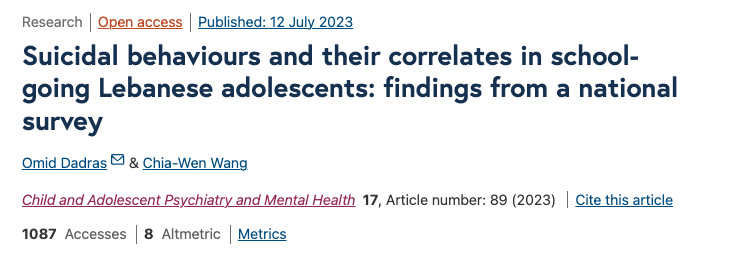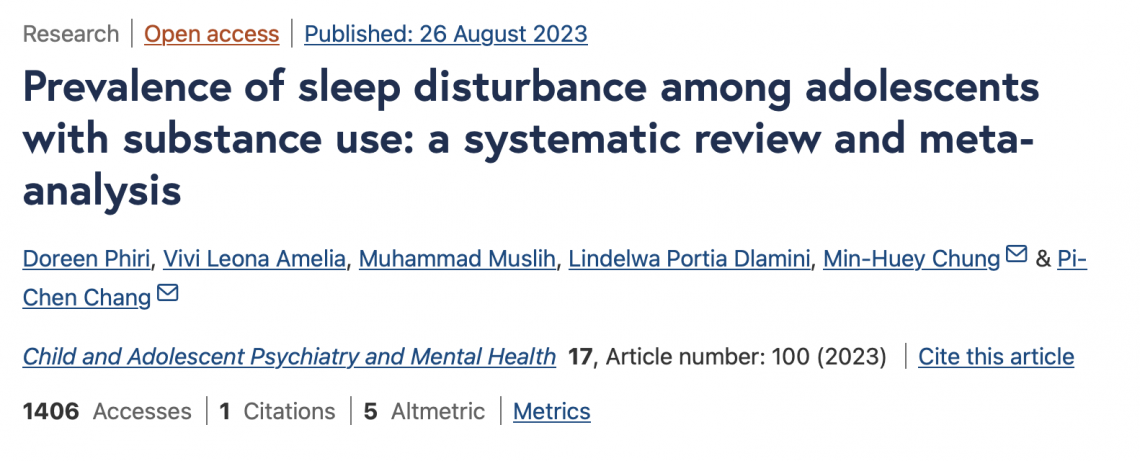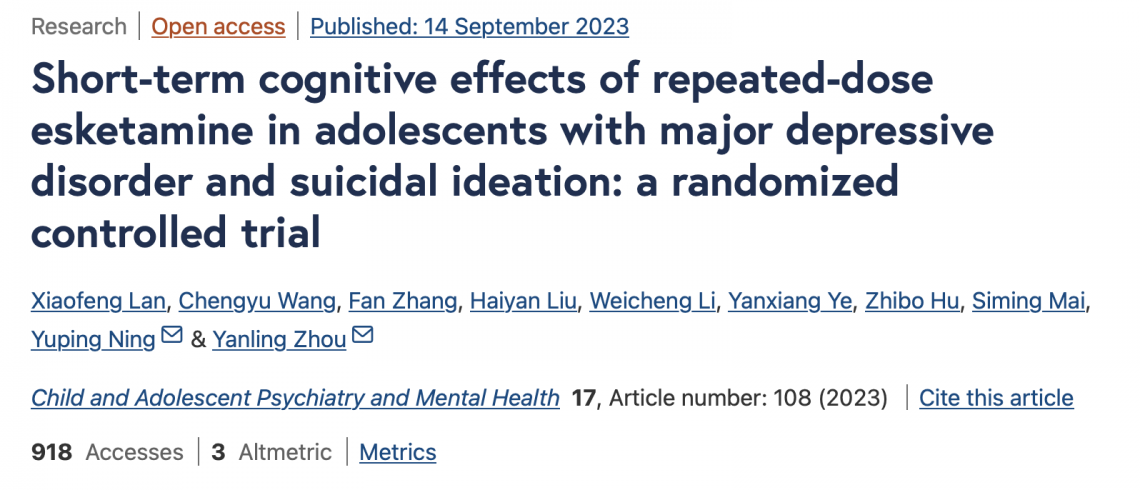CAPMH Corner (Updated Dec 2023)
By: Lakshmi Sravanti, India, Associate Editor, CAPMH
Child and Adolescent Psychiatry and Mental Health (CAPMH) is the official IACAPAP Journal. The "CAPMH Corner" of the December 2023 issue of IACAPAP Bulletin summarizes the following three studies recently published in CAPMH – Suicidal behaviours and their correlates in school‑going Lebanese adolescents: findings from a national survey (Dadras and Wang., 2023), Prevalence of sleep disturbance among adolescents with substance use: a systematic review and meta-analysis (Phiri et al., 2023) and Short‑term cognitive effects of repeated‑dose esketamine in adolescents with major depressive disorder and suicidal ideation: a randomized controlled trial (Lan et al., 2023).
Dadras and Wang et al., (2023) highlight the risks associated with adolescence and the need to study suicidal behaviours among Lebanese adolescents. They investigate the prevalence and association of suicidal behaviours with physical/psychological harm and substance use in adolescents in Lebanon.
The team carries out a secondary data analysis using data from the 2017 Lebanon Global School -based Student Health Survey (GSHS). The Centres for Disease Control and Prevention (CDC) employs a two-stage cluster sample design to ensure a representative sample of students in Grades 7–12. Fifty-six of the 64 selected schools participate in the survey, resulting in a school response rate of 88%. And 5717 of the 6152 selected students complete the survey leading to a student response rate of 93%. They administer the standard GSHS questionnaire to the students during a regular class period. They analyse the outcome variables suicidal ideation and suicide attempt using specific questions generating binary “yes” or “no” answers. They conduct multivariate analysis and logistic regression analysis.
The authors report that the mean age of participants was 14.60 (± 0.14) years old and there was a relatively equal weighted proportion of males (46.81%) and females (53.19%). An estimated 13.45% of Lebanese adolescents in Grades 7–12 seriously considered suicide in the previous year, of whom 46.82% attempted suicide. Females were more likely to attempt suicide (aOR = 1.35; 95%CI : 1.02–1.78). About 73% of the adolescents reported having parental support (understanding of worries and problems) sometimes/most of the time/always in the last 30 days, and they were less likely to consider suicide than those who did not receive such support. They further add that 17.47% of the adolescents had a history of drinking alcohol at least once a month, and only 8.21% had ≥ 2 drinks per day on occasion. Alcohol consumption was associated with a higher likelihood of suicidal ideation and attempt, with higher frequency and quantity being strong predictors of a higher risk of suicidal behaviours. They also mention that 141 (2.39%) and 90 (1.52%) adolescents reported, marijuana and amphetamine use at least once in their lifetime, respectively, There was a significant association between ever (aOR = 6.09; 95%CI : 4.09–9.08) or current (aOR = 6.00; 95%CI : 2.94–12.24) marijuana and ever amphetamine (aOR = 4.16; 95%CI : 2.50–6.91) use with suicidal ideation but not with subsequent suicide attempts, except for marijuana use (aOR = 2.66; 95%CI : 1.24–5.67).
The team acknowledges the limitations of their study – underreporting (teenagers who lacked relevant demographic information or not enrolled in school were excluded); inability to determine the factors that lead to a successful suicide attempt; and inability to establish causal relationships due to cross-sectional nature of the study. They underscore that the data were drawn from the WHO’s Global Schools Health Survey, and the study’s large sample size ensured the diversity and representativeness of the data. They conclude that future interventions and policies should consider the attributes of the risk group susceptible to engaging in suicide attempts identified in the study when monitoring target groups and highlight the importance of awareness campaigns engaging all stakeholders, particularly parents.
Phiri et al., (2023) emphasize that sleep disturbances have become a public health concern and elaborate the most common categories of sleep disturbance in the International Classification of Sleep Disorders-Third Edition (ICSD-3). They highlight the neurobiological changes in the circadian rhythm and sleep homeostasis, and substance use leading to sleep disturbances in adolescents. They conduct a systematic review and meta-analysis that examined the prevalence and categories of sleep disturbance among adolescents with substance use.
The authors register their study with PROSPERO. Subsequently they selected search terms following the population, exposure, and outcome (PEO) format, where P is adolescents, E is substance use, and O is sleep disturbance. They search for relevant studies in CINHAL (via EBSCOhost), PubMed, Scopus, Ovid Medline, Embase, PsychINFO (via EBSCOhost), and the Web of Science from inception to October 2021. They also identify additional relevant studies by manually searching the reference lists of the included studies and other reviews. They use endnote version X9 to screen papers. Two independent reviewers screen and select the articles. They consult a third reviewer when they could not agree. They include observational studies (cross-sectional or cohort) involving adolescents aged 10 to 24 years who used substances (alcohol, smoking, marijuana, and coffee) and experienced sleep disturbance due to substance use [insomnia, hypersomnolence, and sleep-related breathing disorders (SRBDs)]. They exclude research abstracts, duplicate studies low-quality studies, non-observational studies, and non-English studies. They systematically carry out data extraction, quality assessment [using a critical appraisal tool developed by the Joanna and Briggs Institute (JBI)] and data analysis (using Comprehensive Meta-Analysis software version 3, random-effects model to consider the uncertainty caused by the variations among the included studies, generate Forest plots and determine p values for the Cochran Q statistic to evaluate the heterogeneity of studies). They also generated a funnel plot to examine the presence of publication bias.
The team includes eighteen articles published between 1993 and 2021 in their study. They report that all the studies included both female and male adolescents with a mean age of 15 (standard deviation: 3.32, range: 10 to 20) years. The percentage of males was slightly higher than that of females (50.2% vs. 49.8%). The total sample size was 124,554, ranging from 596 to 28,839. Most of the studies were conducted in the United States (n = 6) and Europe (n = 6), and five studies were conducted in Asia and one in Oceania. The majority of participants were from Asian countries (n = 47,511). They mention that 16 studies used a cross-sectional study design, and two studies used a prospective cohort study design. About 83% of the included studies used the self-report method of assessment, while the rest used the face-to-face method. The further report that the overall prevalence rate of sleep disturbance was 29% (95% CI: 0.201–0.403). They subgroup analysis reveals that the prevalence rates of insomnia and hypersomnolence were higher among alcohol users (31%; 95% CI: 0.100–0.654) and smokers (46%; 95% CI: 0.232–0.700). The source of variation in the included studies were the study design and method of assessment groups that were the significant moderators.
The authors mention the strengths of their study and – team conducted a meta-analysis to determine the prevalence rate and categories of sleep disturbance; included high- to moderate-quality studies; and the majority of the included studies had adequate sample sizes. They also acknowledge its limitations – the number of studies was insufficient to pool prevalence rates among the categories of sleep disturbance and substances used; all the included studies used subjective measures of outcomes; the lack of information on other psychiatric comorbidities related to sleep disturbance and substance use among adolescents. They indicate that sleep disturbances among adolescents with substance use could be a global concern that warrants research attention and suggest future studies should include longitudinal studies for more insights on the effects of substance use on sleep disturbances over a longer period among adolescents. They conclude by highlighting the clinical implications of their findings – which can help healthcare providers develop focused effective interventions and underscore the importance of preventive and promotive school health educational programs in reducing substance use and improving regular sleep and wake time timetables among adolescents.
Lan et al., (2023) discuss the safety and success of ketamine and its enantiomer in treating depression and the possibility of cognitive deficits due to its use. They aim to evaluate the effects of esketamine on cognition in adolescent population with MDD and suicidal ideation. They conduct a secondary analysis of the data obtained from a randomized (1:1), double-blind, placebo-controlled trial that was done in the Affiliated Brain Hospital of Guangzhou Medical University between December 2020 to April 2022 (Liu et al., 2022).
The team screens a total of 155 participants for eligibility from the original trial and enroll 54 who received at least one infusion of the study drug. They randomize participants in a 1:1 ratio to receive three infusions of either esketamine hydrochloride or midazolam (active control) via a computer-generated randomization scheme and administer study drugs on Days 1, 3 and 5. They infuse Esketamine 0.25 mg/kg or midazolam 0.02 mg/kg in 50 ml 0.9% of saline over 40 min via an infusion pump. The authors note that all potential participants were admitted to hospital and received standard care treatment. They administer Montgomery–Asberg Depression Rating Scale (MADRS), the first five questions of the Beck Scale for Suicide Ideation (SSI), 17-item Hamilton Depression Rating Scale (HAMD-17) at screening, clinician-rated Columbia suicide severity rating scale (C-SSRS), and the Chinese version of MATRICS consensus cognitive battery (MCCB) administrated at baseline, Days 6 and 12. They perform statistical analysis by the intention-to-treat (ITT) principle.
The authors include 51 participants (25 in the midazolam group and 26 in the esketamine group) who completed measurements of cognitive performance and clinical symptoms both at baseline and Day 6 were included in the final analyses. They note that the generalized estimation equation showed no significant association between baseline cognition and antidepressant or antisuicidal effect (both P > 0.05), and that the Esketamine group showed improvement in processing speed from baseline to Days 6 and 12, and working memory from baseline to Day 12 (all P < 0.05).
The authors mention that their team was the first to give a full report of the effects of repeated esketamine infusions on the cognition of adolescents. They also acknowledge the limitations of their trial – secondary analysis of a randomized trial that was not powered to detect changes in cognition due to its relatively small sample size; cognitive performance was only assessed at baseline, Days 6 and 12; did not include sustained attention, social cognition and other common cognitive impairments seen in adolescents with depression; suicidal ideation was assessed using only the first five items of SSI; oral antidepressant medications were provided concomitantly with esketamine or midazolam during the infusion phase; and repeated measures of MCCB within 12 days may have learning/practice effects especially in the dimensions of processing speed and working memory. They conclude that three low-dose esketamine infusions did not impair the short-term cognitive function of adolescents with MDD and suicidal ideation; conversely, it improved processing speed.
REFERENCES:
- Dadras, O., Wang, CW. Suicidal behaviours and their correlates in school-going Lebanese adolescents: findings from a national survey. Child Adolesc Psychiatry Ment Health 17, 89 (2023). https://doi.org/10.1186/s13034-023-00642-7.
- Lan, X., Wang, C., Zhang, F. et al. Short-term cognitive effects of repeated-dose esketamine in adolescents with major depressive disorder and suicidal ideation: a randomized controlled trial. Child Adolesc Psychiatry Ment Health 17, 108 (2023). https://doi.org/10.1186/s13034-023-00647-2.
- Liu, H., Lan, X., Wang, C., et al. (2022) The efficacy and safety of esketamine in the treatment of major depressive disorder with suicidal ideation: study protocol for a randomized controlled trial. BMC Psychiatry, 22(1), 744.
- Phiri, D., Amelia, V.L., Muslih, M. et al. Prevalence of sleep disturbance among adolescents with substance use: a systematic review and meta-analysis. Child Adolesc Psychiatry Ment Health 17, 100 (2023). https://doi.org/10.1186/s13034-023-00644-5.




